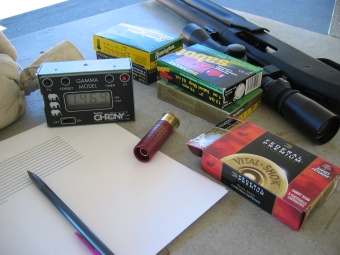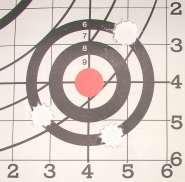
With a handload plan in place, it was time to collect some baseline data from the Mossberg so I would know if my handloads would actually offer improved performance, or if I would have to lie. So we packed up the gear and headed up to Los Altos Rod and Gun Club.
I think shotgunners, unless they check in and move immediately to the skeet and trap area, are always viewed by range officials as “suspect”. Sure they tell us they are worried about the range’s target supports and other shooters targets being pelted with mysterious .12 caliber bullets, but I think there is more to it than that. Maybe they are wondering why someone would be shooting slugs from a shotgun when there are no local hunting restrictions that warrant the selection. Of course the odd reception could have been caused by my wife; she tends to tape little signs on my back without my knowledge because in her words, “It’s just damn funny”. I love that woman, she just makes me a little crazy at times. Let me back up a bit….
A little gun prep

When is a shotgun, not a shotgun? When it’s tossing 600 grains of cohesive lead. You have to admit, that’s a lot of fun. After mounting a set of Williams Fire Sights on the Mossberg’s rifled barrel, I needed to get a scope mounted to give a fair shake to the gun’s performance over a longer distance with slugs. The approach isn’t as straight forward as it might seem because the scope could be mounted on the receiver or, as the current wisdom suggests, mounted on the barrel.
The thought is that guns with less than a threaded union of barrel and receiver tend to allow those two parts to move out of perfect unison, therefore the glass should be anchored to the part that most controls the direction of the moving projectile. There is another school of thought that suggest rapidly heating barrels and thin barrel walls make lousy places to hold something in critical alignment. I kind of liked the later, especially since receiver mounting was less costly and the mount decision reversible, so that is the direction I took. I spent $6 for Weaver mount base; Model 417M, one piece matte finish that dropped right over the 4 predrilled holes in the 835 Mossberg’s receiver. I also picked up a set of permanently attached, as opposed to quick release, Warne Maxima Series Steel Rings for $25.
Not wanting to risk a very expensive scope, mostly because I don’t really own one, I pulled a scope from my CVA muzzle loader; a cheapo Cabela’s 2.5-7x32mm matte finished shotgun/black powder Pine Ridge scope. The “shotgun/black powder” scope designation mostly means the scope has a little more eye relief, 4″, and parallax is preset to 50 yards rather than 100 yards. For a cheap scope the glass is crystal clear, the image is sharp and with just the right amount of contrast.
I knew the Warne rings would hold up to the recoil and prevent the scope from beating itself to death. The four Allen head screws would lock the scope to the mount and the Warne cross bar, arrow, would make sure the scope did not move fore or aft. Besides being incredibly strong, they are a nice looking set of rings.

The Mossberg pump, with its closed receiver, requires either a boresight or 2,000 rounds of ammo to properly dial in a scope. I opted for the boresight. I’ve been using this Simmons boresighter for years, mostly because it works and is very adaptable. I retired the included spuds almost immediately, and replaced them with B Square adjustable spuds. If you’ve used the Simmon’s unit with the stock bore adapters , you know they are secured against radial movement by a small phosphor bronze clip that pops into a barrel groove and prevents the weight of the boresighter from causing it to rotate unexpectedly. Unfortunately, this isn’t a great approach so I substitute adjustable spuds. The adjustable spuds expand to fill the bore and lock the assembly tightly in place. Three units are required to cover the range from 17 to 50 caliber.
The .729″ 12 gauge required a larger spud and Cabelas has a store brand shotgun boresighter arbor (spud) worked great with the Mossberg and the Simmons unit. At $29.99 it is a more expensive than an $18 dedicated size spud, but it is adjustable from 10 to 20 gauge. Why not a laser boresighter ? The Simmons or similar Tasco or Bushnell boresighter with full set of fixed arbors runs in the neighborhood of $40 – $50 another $18 for the fixed 12 gauge tooling. For under $70 you can have a reliable piece of equipment that is very durable and the batteries will never go dead.
Defining the slug shooting experience

“Ouch!”, “Damn!”, “Gees!”, “Crap!” “That smarts!”, “Am I bleeding?” are all terms that pretty much defined my first impressions of shooting a light weight pump slug gun. The recoil is not serious, or at least not severe at 55 ft/lbs or so, but a light gun with bad recoil handling habits and a narrow recoil pad combined for accumulative damage.
Rogue’s Gallery (L-R) Brenneke 1 3/8 oz, Remington Buck Hammer 1 3/8 oz, Brenneke 1 oz, Remington Copper Solid 1 oz, and Federal 1 oz Barnes expander. They are all 3″ loads. All fed predictably reliably, however, something about the Federal hull made it eject with a lot more velocity. Means nothing, just different than the others. Only the Remington Copper Solid Magnum and Federal have what I would call a traditional sabot holding an under sized projectile. The others were closer to a full bore slug wrapped in Teflon or placed in a thin wall shot cup. The Buck Hammer was a hybrid, somewhere between both; a full size slug, but an underneath substantial supporting sabot.

It’s easy to tell one load from another when checking a target. The Brenneke’s vaned slug leaves a hole like a giant wad cutter with cogged teeth. The Buck Hammer punches a perfectly clean hole and the sabot rounds make normal bullet holes. Is this important? Yes. The way these things sprayed the target, the “fingerprints” were a great aid in figuring out what landed where. The 1 3/8 Brenneke group on the left is 2.7″. The one ounce Brenneke grouped once at 1 .4″, the Remington Copper solid grouped 3″, the Remington Buck Hammer ran slightly over 2″ and velocity was consistent. The Federal Barnes Expander 5″ group was all over the place, not only in point of impact, but also in recorded velocity. I am not so sure how much of this is reflective of the ammo and how much should be attributed to the gun’s configuration.

The only way for me to shoot a stable group was to sand bag under my arms and leading hand, while I held the gun at the bench. Probably not as weird as that sounds, I’ve had plenty of lever guns and autoloaders that were sensitive to forward barrel pressure. In this case, I could scatter shots just by varying sand bag under barrel pressure or under action pressure.
As noted previously, there isn’t much holding a barrel in a pump shotgun; loosen the magazine cap, bring the action back half stroke and the barrel pops right out. There are no heavy threads or a hundred ft/lbs of torque to closely tie all of the parts together. Consequently, a scope mounted to the receiver will remain in line with the receiver while the barrel is free to move out of alignment. These are small amounts of movement, but that’s all it takes. At this point, just a theory, but one held by more than a few people. I have heard a lot about 1″-2″ slug gun groups, and I’d really like to see them. To that end I ordered a barrel with a cantilevered scope mount and I will reassess common point of impact potential when the barrel is received. If barrel movement and receiver mounted sights are the core of the problem, the current barrel will not go to waste, it has Williams Fire Sight that are barrel mounted.
Performance Summary
|
3″ Magnum Slug Loads |
Product | 100 Yd Group | MV |
 |
Federal Barnes-Expander | 5.0″ | 1413 |
| Remington Copper Solid | 3.0″ | 1442 | |
| Brenneke 1 oz | 1.4″ | 1598 | |
| Remington Buck Hammer | 2.0″ | 1477 | |
| Brenneke 1 3/8 oz | 2.7″ | 1518 |
Slug Load Penetration

From the standpoint of penetration, this test left me unimpressed. The Chrony was hit pretty much straight on, the slug was deflected, it bounced up and sheared off one of the skylight filter rods. Oddly, it never spun the chronograph on the tripod or knocked it over. In fact, it didn’t do all that much damage. Yes I am kidding, trying to take the stress out of the second such loss in 5 years while wondering how I will better align the Chrony on a grade, in an unfamiliar setting, with a pretty good assurance of a successful outcome, meaning I will return home with a working Chrony. Still, it does make me wonder how this thing sustained such minor damage with such a direct hit. I will do some penetration testing when I test handloads and reshoot with the new scoped barrel set up.
I am going to take a break from shotguns for a bit while I accumulate all of the new material. I actually have some pretty tricky handload combinations put together and, preliminarily some good results. Be back soon….with the Oehler Model 43 this time.
Everything I know About Shotguns… Part 1
Everything I know About Shotguns… Part 2
Everything I know About Shotguns… Part 3
Everything I know About Shotguns… Part 4
Thanks,
Joe

Email Notification